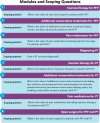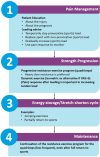Dutch multidisciplinary guideline on anterior knee pain: Patellofemoral pain and patellar tendinopathy
- PMID: 39045713
- PMCID: PMC11792096
- DOI: 10.1002/ksa.12367
Dutch multidisciplinary guideline on anterior knee pain: Patellofemoral pain and patellar tendinopathy
Abstract
Purpose: The purpose of this study was to develop a multidisciplinary guideline for patellofemoral pain (PFP) and patellar tendinopathy (PT) to facilitate clinical decision-making in primary and secondary care.
Methods: A multidisciplinary expert panel identified questions in clinical decision-making. Based on a systematic literature search, the strength of the scientific evidence was determined according to the Grading of Recommendations, Assessment, Development and Evaluations (GRADE) method and the weight assigned to the considerations by the expert panel together determined the strength of the recommendations.
Results: After confirming PFP or PT as a clinical diagnosis, patients should start with exercise therapy. Additional conservative treatments are indicated only when exercise therapy does not result in clinically relevant changes after six (PFP) or 12 (PT) weeks. Pain medications should be reserved for cases of severe pain. The additional value of imaging assessments for PT is limited. Open surgery is reserved for very specific cases of nonresponders to exercise therapy and those requiring additional conservative treatments. Although the certainty of evidence regarding exercise therapy for PFP and PT had to be downgraded ('very low GRADE' and 'low GRADE'), the expert panel advocates its use as the primary treatment strategy. The panel further formulated weaker recommendations regarding additional conservative treatments, pain medications, imaging assessments and open surgery ('very low GRADE' to 'low GRADE' assessment or absence of scientific evidence).
Conclusion: This guideline recommends starting with exercise therapy for PFP and PT. The recommendations facilitate clinical decision-making, and thereby optimizing treatment and preventing unnecessary burdens, risks and costs to patients and society.
Level of evidence: Level V, clinical practice guideline.
Keywords: conservative treatment; knee; knee joint; patellofemoral pain syndrome; tendinopathy.
© 2024 The Author(s). Knee Surgery, Sports Traumatology, Arthroscopy published by John Wiley & Sons Ltd on behalf of European Society of Sports Traumatology, Knee Surgery and Arthroscopy.
Conflict of interest statement
The personal financial interests, personal relationships, external research funding, intellectual property, and other potential conflicts of all the authors are described in the online Supporting Information.
Figures



References
-
- Alshaharani, M.S. , Lohman, E.B. , Bahjri, K. , Harp, T. , Alameri, M. , Jaber, H. et al. (2020) Comparison of Protonics™ knee brace with sport cord on knee pain and function in patients with patellofemoral pain syndrome: a randomized controlled trial. Journal of Sport Rehabilitation, 29(5), 547–554. Available from: 10.1123/JSR.2018-0171 - DOI - PubMed
-
- van Ark, M. , Cook, J.L. , Docking, S.I. , Zwerver, J. , Gaida, J.E. , van den Akker‐Scheek, I. et al. (2016) Do isometric and isotonic exercise programs reduce pain in athletes with patellar tendinopathy in‐season? A randomised clinical trial. Journal of Science and Medicine in Sport, 19(9), 702–706. Available from: 10.1016/J.JSAMS.2015.11.006 - DOI - PubMed
-
- Arkel, E. , van Essen, B. , Koeter, S. , van Melick, N. , Rijk, P. & Segers, M. et al. (2019, April 3) Artroscopie bij patellofemoraal pijnsyndroom. Available from: https://richtlijnendatabase.nl/richtlijn/artroscopie_van_de_knie/artrosc...
-
- Babatunde, F. , MacDermid, J. & MacIntyre, N. (2017) Characteristics of therapeutic alliance in musculoskeletal physiotherapy and occupational therapy practice: a scoping review of the literature. BMC Health Services Research, 17(1), 375. Available from: 10.1186/s12913-017-2311-3 - DOI - PMC - PubMed
Publication types
MeSH terms
Grants and funding
LinkOut - more resources
Full Text Sources
Medical
Research Materials

